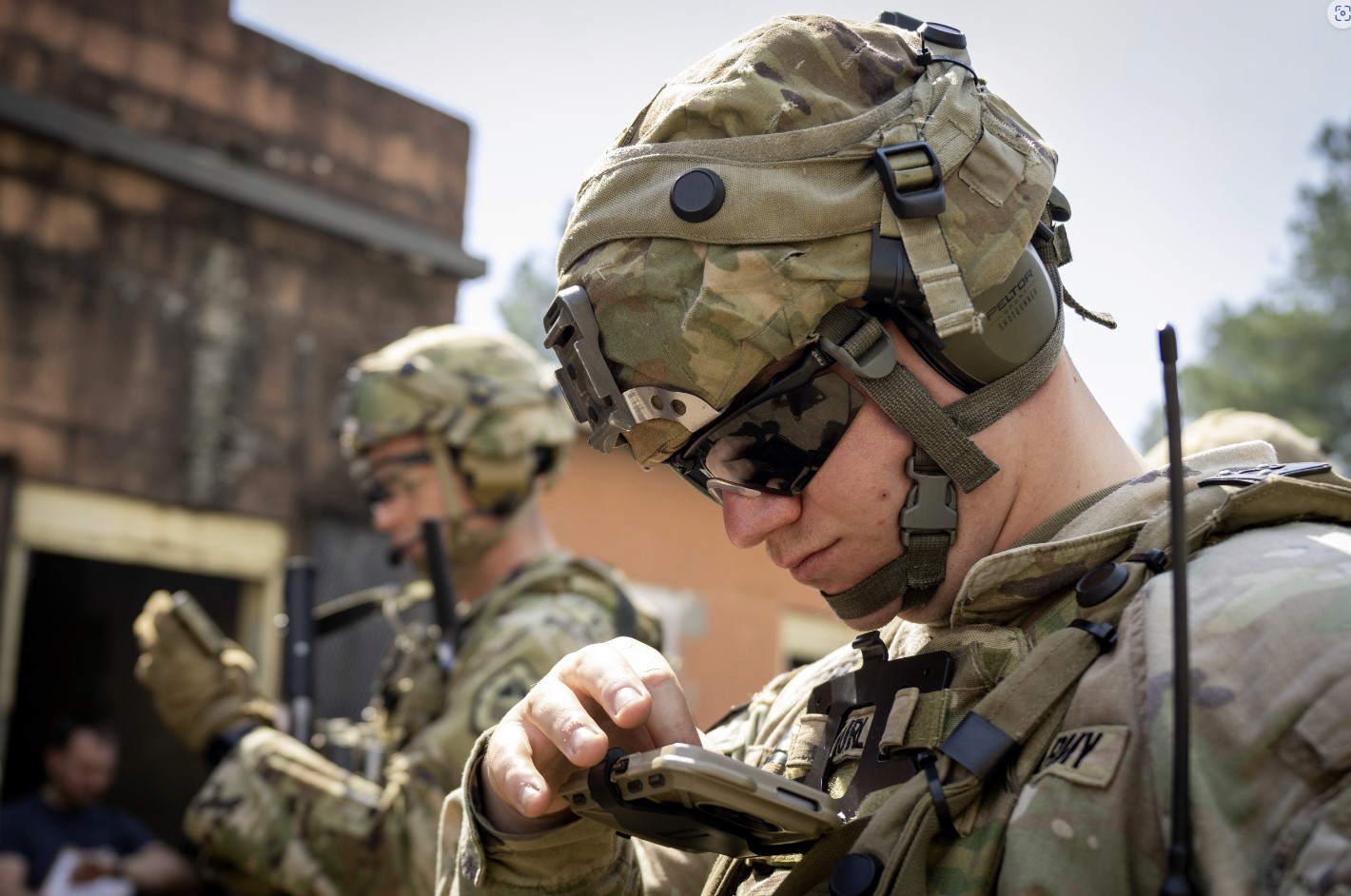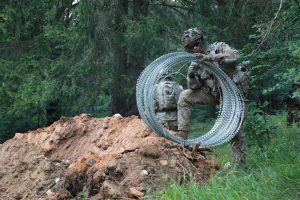1000 Days In – Junior Officers and the Ukraine-Russia Conflict – Continued Learning Part Two

In July of 2023, the Center for Junior Officers published a piece titled “500 Days and Counting – what Junior Officers can learn from the Ukraine-Russia Conflict.” Both Ukrainian and Russian forces have suffered high losses which required significant reconstitution of junior officers. The article discussed why junior officers need trust for cohesion, the difficulties with constantly rebuilding team dynamics, and why these aspects deserve focus. In the last ~500 days since the previous article, dialogue in the media and among leaders in the Department of Defense has shifted to focus on the impact technological integration into small units has played out on the front lines. “Part Two” provides further recommendations for Junior Officers on how to integrate technology into their training to continue to learn from this conflict.
Leaders, Trainers, and Trainees Build Unit Confidence
The modern battlefield, dominated by unconventional warfare, is saturated with technology that did not exist just a few years ago. It is essential that this technology is well understood and incorporated into training at every opportunity. The connective tissue between Part One and Part Two of this article series, put simply, is that trust and cohesion are built far afront of combat when junior officers conduct innovative, complex, and challenging training. In training scenarios that the junior officer and their team dream up and execute, they develop the ability for teammates to think critically before, during, and after engagements. Diverse and complex training enables rapid problem-solving and builds competence and confidence that will allow your unit to extrapolate lessons learned to a wider range of problems. To paraphrase Erwin Rommel, “Training errors are recorded on paper. Tactical errors are etched in stone.” Leaders, trainers, and trainees must come together as a “triangle of power” to understand and develop responsibilities and outcomes for training objectives.
There are two key recommendations we have for junior officers that seek to leverage the technological integration lessons learned from the last 1000 days and build confidence in their units through tough training
1. Leverage the many ways to train with and against the breakthrough threat of drones
2. Use unit innovation labs to solve complex technical problems.
If you are not leveraging drones, or training with or against them, you should be.
Home station tactical training should not be a place where your OPFOR is unmotivated, unchallenged, or representative of the same canned exercises and scenarios based on past conflicts. Junior officers are uniquely positioned in their units with less previous experience (and thus, bias) to try new things and test what works. Military theorist Carl Von Clausewitz states, there is no point in learning extensively if “knowledge does not become capability.” To that extent officers and leaders at every level only benefit from lessons learned from the Ukrainian front lines when these lessons are incorporated into innovative training at all levels. Drones are but one example that we see contemporarily – and utilizing them in training allows Junior Officers to translate lessons from Ukraine into effective training. An open-source tool to think through how a junior officer could plan event oriented training is the ACLED (Armed Conflict Location and Event Data), a disaggregated data mapping initiative. Filtering from the start of the Russia-Ukraine conflict, we see an increase from 53 incidents of “explosions and remote violence” due to air and drone strikes during the first week of conflict, to 466 incidents during the week of 6 September 2024. When using open-source data such as this, we also see differences in logistical patterns and opposing force adaptation. Material adaptation is facilitated by utilizing cheaper, more easily implementable platforms such as drones to validate targets effectively before expending expensive munitions, saving material production times and costs. Thus, we can assess with strong confidence that strike patterns will incorporate drones in the foreseeable future, more lightly augmented by artillery fires in support, depending on the disposition of the enemy force and how significant of a threat it might be deemed.
Junior officers can test new tactics in training by thinking through data sets like ACLED, combined with validation of opposing force SOPs from their intelligence sections. In the ACLED data set, the second-highest subsets of events across the span of conflict are “shelling events” and “armed clashes.” Simply speaking, a junior officer could connect these data points and their interrelation to drive tactical training. For example, you may need to refine SOPs when moving to contact with sUAS on the battlefield. Once the drone is identified during your movement, the squad, or platoon, has x amount of time to address the threat and re-locate based on the known responses, firing times, and round analysis of opposing force artillery pieces. Real-time data and knowledge of enemy-combined arms strategies drive this training concept. A training event like this might let junior officers know that no matter how good their SOPs are, maybe they don’t have the right tools to detect drones far enough out or react to ground and aerial contact simultaneously. These become “red flags” in training that can be brought up elsewhere.
Both Ukraine and Russia continue to integrate unmanned aerial systems in all layers of warfare across the battlespace, which requires the competence to detect, defeat, and deter them. Junior officers must focus on how to enable their forces (at the lowest level) to effectively handle these rapidly replenished and cost-effective systems. Finer points of training should incorporate both ISR and counter-ISR principles. Making your formation familiar with the components of drone warfare should include how you maneuver your formations, the cover you choose, EM and thermal signature discipline, utilization of deception, and how you detect and defeat sUAS and other unmanned aerial systems.

Make your Training Pay Off at “Echelons Above You” – Leveraging Your Unit’s Tactical Innovation Lab
Being on the front lines, JOs, NCOs, and their Soldiers have the most intimate knowledge of tactical problems. Tactical Innovation Labs help to turn good ideas to solve these problems into reality. Nearly every Division in the Army is now home to a Tactical Innovation Lab. This is the nexus of the soldier-centered, bottom-up innovation occurring across the operational Army. These labs have three primary outcomes: train and equip Soldiers to solve technical problems at the tactical edge, produce stop-gap solutions to emergent problems, and experiment in training to inform long-range Army Futures Command and acquisitions projects. Junior officers should leverage their local Tactical Innovation Lab to educate their units on the cutting-edge technologies and methods for implementing them into your training. Tactical Innovation Labs are resourced to enable junior officers, NCOs and Soldiers to rapidly produce low-cost prototype solutions or surrogates of advanced technology to use in training.
Following a recent NTC rotation, leaders from the 3rd Infantry Division at Fort Stewart integrated the Marne Innovation Center, their Division’s tactical innovation lab, into their AARs to help identify capability gaps. In the subsequent months, Soldiers partnered with the innovation team to prototype solutions to these gaps and begin integrating them into their training immediately. During the next rotation, the Brigade was able to successfully field and utilize autonomous breaching capabilities, low-cost RF decoys, tethered UAS, and automated targeting software. The unit successfully employed technology that did not exist a year prior against a formidable OPFOR by partnering with their Tactical Innovation Lab and implementing the new technology into training early and often. Junior officers spearhead these efforts and many others at tactical innovation labs.
Integrate the tactical innovation cells and their resources into your training at every opportunity, from testing new equipment at large-scale collective training events to rapidly iterating on prototypes on STX lanes during Squad Leader time. Observing the key role deception has played in the Russo-Ukraine conflict, a junior officer from 92nd Engineers and her Soldiers, alongside their Tactical Innovation Lab, designed and fabricated decoy Bradley Fighting Vehicles out of plywood and low-cost emulators which mimicked radio chatter to train on and employ against OPFOR, for example. Additionally, provide your Soldiers the time to step out of their standard day job and work to develop innovative solutions to their problems. Finally, use your innovation lab to communicate good ideas to higher and to receive access to cutting-edge technology being developed within Army Futures Command to train with and evaluate before they are fielded force-wide.
500 days after the first 500 days
There are takeaways abound from the front lines of the Ukraine-Russia conflict. Thinking critically about what the junior officer can affect through effective, innovative, complex training makes your teams more prepared, more cohesive, more lethal, and more creative. Leverage the “triangle of power” of Leaders, Trainers, and Trainees, to plan challenging training. Read about drone warfare, learn opposing force tactics, and use critical thinking to plan scenarios that are challenging and realistic. And finally, work with your organizations (in full) to resource effective training and advocate for your needs. Share your lessons with everybody that they apply to. Knowledge is a force multiplier. Many tools can be leveraged to help make organizational growth during complexity a reality. Seek knowledge, experts, progress, and innovative experiences – find what works (and what does not), and repeat. Understand prudent risk and continue to challenge your formations to achieve and maintain tactical dominance. Through this, junior officers of our Army can continue to learn and from these last 1000 days and stay ready for the potential of future fights in the days to come.
Authors Biographies
Major Nicholas Rich is a senior instructor in the United States Military Academy’s Department of Behavioral Science and Leadership. Nicholas is passionate about the intersection of innovation and leadership. He teaches Military Leadership, Sociology, and Agile Innovation in Defense.
Captain Chris Aliperti is an instructor in the United States Military Academy’s Department of Civil and Mechanical Engineering. Chris additionally serves as an Associate Director in the Department’s Center for Innovation and Engineering and a Founding Director of the Tactical Innovation Institute.
Related Posts

Going Off Script, But Staying on Track: A Career Guide for Junior Leaders
Intro I walked into LTC Tomi King’s office as a new 2LT in his formation. We discussed all the normal talking points in that initial counseling – family, where I …

Fighting as an Enabler Leader
(U.S. Army Photo by Cpl. Tomarius Roberts, courtesy of DVIDS)Enablers provide capabilities to commanders that they either do not have on their own or do not have in sufficient quantity …

Defeating the Drone – From JMRC’s “Skynet Platoon”
If you can be seen, you can be killed—and a $7 drone might be all it takes. JMRC’s Skynet Platoon discuss their TTPs to defeat the drone.
